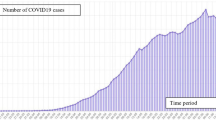Abstract
The Novel Coronavirus (nCoV or COVID-19) that hit the City of Wuhan in the Hubei Province of China in December last year has become the greatest concern throughout the world. The countries in the world have shown a significant difference in the control of the spread of disease and the mortality rate. Kerala—a southern state in India—has shown notable performance in the field of disease control of COVID-19. Various measures of disease control are proved effective in the containment of COVID-19. A study of the situation in Kerala after the outbreak of COVOD-19 is used to analyze the effect of the control strategies. In this chapter, the main focus is on a comparative study of the predictions of the SIR model and the actual performance made by the state in controlling the disease.
Access this chapter
Tax calculation will be finalised at checkout
Purchases are for personal use only
Similar content being viewed by others
References
World Health Organization. (2020). Coronavirus disease 2019 (COVID-19) Situation Report—152. WHO. Available from. https://www.who.int/docs/defaultsource/coronaviruse/situation-reports/20200620-covid-19-sitrep152.pdf?sfvrsn=83aff8ee_4. Accessed on June 23 2020.
https://www.who.int/csr/don/05-January-2020-pneumonia-of-unkown-cause-china/en/. Accessed on 30 June 2020.
https://www.who.int/csr/don/12-January-2020-novel-coronavirus-china/en/. Accessed on 30 June 2020.
https://www.who.int/csr/don/14-January-2020-novel-coronavirus-thailand/en/. Accessed on 30 June 2020.
https://www.who.int/csr/don/17-January-2020-novel-coronavirus-japan-ex-china/en/. Accessed on 30 June 2020.
https://www.who.int/csr/don/21-January-2020-novel-coronavirus-republic-of-korea-ex-china/en/. Accessed on 30 June 2020.
https://www.who.int/docs/default-source/coronaviruse/situation-reports/20200402-sitrep-73-COVID-19.pdf?sfvrsn=5ae25bc7_6. Accessed on 30 June 2020.
https://en.wikipedia.org/wiki/Timeline_of_the_COVID-19_pandemic_in_India. Accessed on 30 June 2020.
Mukesh, R. (2020). Coronavirus in India: Tracking country’s first 50 COVID-19 cases; what numbers tell. India Today. Retrieved 12 March 2020.
Ajith Kumar, A. K., & Anoop Kumar, A. S. (2018). Deadly Nipah outbreak in Kerala: Lessons learned for the future. Indian Journal of Critical Care Medicine, 22, 475–476.
Arunkumar, G., Chandni, R., Mourya, D. T., Singh, S. K., Sadanandan, R., Sudan, P., et al. (2018). Outbreak investigation of Nipah virus disease in Kerala, India, The Journal of Infectious Diseases, https://doi.org/10.1093/infdis/jiy612.
Brauer, F., Van den Driessche, P., & Wu, J. (Eds.). (2008). Mathematical epidemiology. Berlin, Heidelberg: Springer.
Kermack, W. O., & McKendrick, A. G. (1927). A contribution to the mathematical theory of epidemics. Proceedings Royal Society London B Biological Science, 115, 700–721.
Kermack, W. O., & McKendrick, A. G. (1932). Contributions to the mathematical theory of epidemics, part. II. Proceedings Royal Society London, 138, 55–83.
Kermack, W. O., & McKendrick, A. G. (1932). Contributions to the mathematical theory of epidemics, part. III. Proceedings Royal Society London B Biological Science, 141, 94–112.
Yang, Z., Zeng, Z., Wang, K., Wong, S. S., Liang, W., Zanin, M., et al. (2020). Modified SEIR and AI prediction of the epidemics trend of COVID-19 in China under public health interventions. Journal of Thoracic Disease, 12(3), 165.
Chen, Y. C., Lu, P. E., Chang, C. S., & Liu, T. H. (2020). A Time-dependent SIR model for COVID-19 with undetectable infected persons. arXiv preprint arXiv:2003.00122.
Calafiore, G. C., Novara, C., & Possieri, C. (2020). A modified sir model for the COVID-19 contagion in Italy. arXiv preprint arXiv:2003.14391.
Roda, W. C., Varughese, M. B., Han, D., & Li, M. Y. (2020). Why is it difficult to accurately predict the COVID-19 epidemic? Infectious Disease Modelling, 5(2020), 271–281.
Alvarez, F. E., Argente, D., & Lippi, F. (2020). A simple planning problem for COVID-19 lockdown (No. w26981). National Bureau of Economic Research.
Maier, B. F., & Brockmann, D. (2020). Effective containment explains sub exponential growth in recent confirmed COVID-19 cases in China. Science, 368(6492), 742–746.
Prem, K., Liu, Y., Russell, T. W., Kucharski, A. J., Eggo, R. M., Davies, N., et al. (2020). The effect of control strategies to reduce social mixing on outcomes of the COVID-19 epidemic in Wuhan, China: a modeling study. The Lancet Public Health.
Fang, Y., Nie, Y., & Penny, M. (2020). Transmission dynamics of the COVID-19 outbreak and effectiveness of government interventions: A data-driven analysis. Journal of Medical Virology, 92(6), 645–659.
Raza, K. (2020). Artificial intelligence against COVID-19: A meta-analysis of current research. In Big Data Analytics and Artificial Intelligence Against COVID-19: Innovation Vision and Approach. Studies in Big Data, 78, 2020. Berlin: Springer (In Press).
Haider Ali Biswas. (2012). Model, and control strategy of the deadly Nipah virus (NiV) infections in Bangladesh. Research and Reviews in BioSciences, 6(12), 370–377.
Reji Kumar, K. (2020). Nipah outbreak in Kerala—A network-based study, to appear in the proceedings of the International conference, ICMMCMSE 2020.
http://dhs.kerala.gov.in/. Accessed on 30 June 2020.
http://dhs.kerala.gov.in/route-map/. Accessed on 30 June 2020.
Acknowledgements
I express my gratitude to the anonymous reviewers for the valuable comments and suggestions that helped me to improve the quality of this chapter.
Author information
Authors and Affiliations
Corresponding author
Editor information
Editors and Affiliations
Rights and permissions
Copyright information
© 2021 The Editor(s) (if applicable) and The Author(s), under exclusive license to Springer Nature Singapore Pte Ltd.
About this chapter
Cite this chapter
Reji Kumar, K. (2021). A Comparative Study of the SIR Prediction Models and Disease Control Strategies: A Case Study of the State of Kerala, India. In: Raza, K. (eds) Computational Intelligence Methods in COVID-19: Surveillance, Prevention, Prediction and Diagnosis. Studies in Computational Intelligence, vol 923. Springer, Singapore. https://doi.org/10.1007/978-981-15-8534-0_8
Download citation
DOI: https://doi.org/10.1007/978-981-15-8534-0_8
Published:
Publisher Name: Springer, Singapore
Print ISBN: 978-981-15-8533-3
Online ISBN: 978-981-15-8534-0
eBook Packages: Intelligent Technologies and RoboticsIntelligent Technologies and Robotics (R0)




